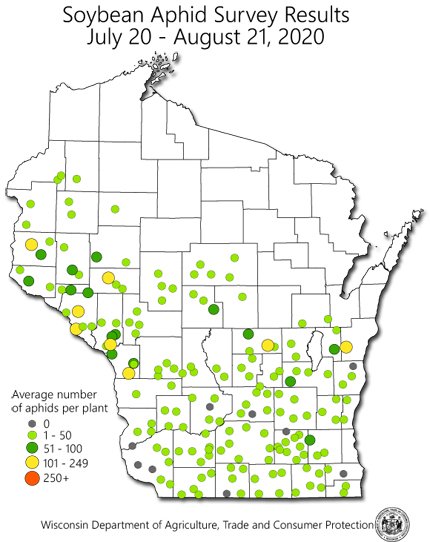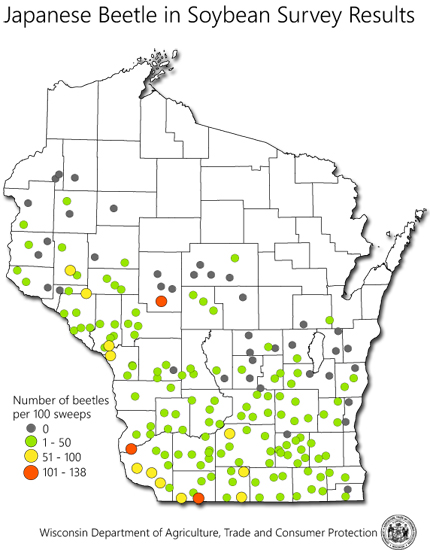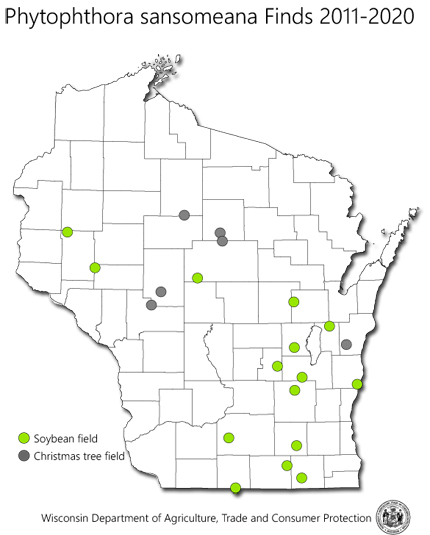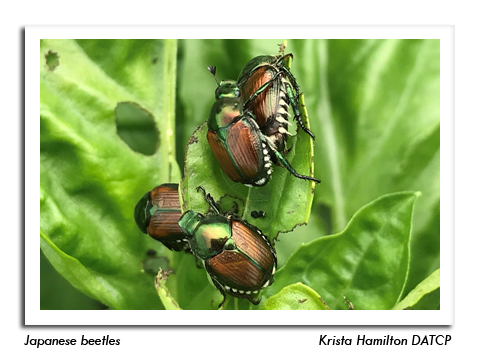
 |
|
|
Soybeans
Volume 65 Number 18 Date 11/12/2020 SOYBEAN APHID - Populations recorded during the annual survey were mostly low. Ninety-one percent of the 180 fields sampled from July 20-August 21 had average counts below 50 aphids per plant, 5% had 51-100 per plant, and only 4% had moderate populations of 101-175 aphids per plant. The 2020 state average count was just 15 aphids per plant, with no surveyed fields showing above-threshold populations of 250 aphids per plant. For comparison, the 2019 survey found a record-low average of five aphids per plant, the 2018 average was 14 aphids per plant, and surveys from 2010-2017 documented average counts of 6-55 aphids per plant. Results of this season's effort suggest that while aphid pressure was slightly higher than in 2019, the soybean fields sampled did not meet treatment guidelines during the survey timeframe. JAPANESE BEETLE - Defoliation was observed in 70% of the 180 soybean fields examined in August. Counts recorded during the annual aphid survey ranged from 1-138 beetles per 100 sweeps, with a state average of 17 per 100 sweeps (the 2019 average was 14 per 100 sweeps). The highest counts of 50 or more beetles per 100 sweeps were noted in the southwestern and west-central districts for the third year in a row. Individual fields in Clark, Crawford, and Lafayette counties had counts exceeding 100 beetles per 100 sweeps and defoliation levels well above the 20% economic threshold for this pest. TWO-SPOTTED SPIDER MITE - Leaf stippling and bronzing symptoms intensified in western Wisconsin soybeans in August with the late summer drought. For most fields, the mite infestations appeared after the R5 to R5.5 or full pod growth stage, which was too late for miticide treatment to be beneficial. SOYBEAN GALL MIDGE - An emerging pest of Midwestern soybeans, the soybean gall midge (SGM) was not found in Wisconsin in 2020. Populations were confirmed this season in Iowa, Minnesota, Nebraska, and South Dakota. Larvae of the SGM, a member of the Hessian fly family (Cecidomyiidae), feed internally at the base of soybean stems and cause stem discoloration. Infested plants snap off near the ground and the orange or white maggots can be found feeding inside. Much remains unknown about this insect, including the exact species and whether it is a direct or a secondary soybean pest. Consultants and soybean growers are encouraged to remain alert for symptoms associated with SGM for 2021 and collect a sample for definitive identification if SGM is suspected. -- Krista Hamilton, DATCP Entomologist SEEDLING ROOT ROT - DATCP surveyed 50 soybean fields from June 8-July 3 for seedling root rot disease caused by Phytophthora sojae, general Phytophthora species, and general Pythium species. Testing at the Plant Industry Bureau Laboratory confirmed 46% (23 of 50) of fields were positive for P. sojae; 6% (3 of 50) of fields were positive for P. sansomeana; and 80% (43 of 50) were infected with Pythium. The P. sojae rate increased from the previous year when the pathogen was identified in 38% of fields. Surveys in the past decade have found P. sojae prevalence ranging from 13% in 2011 to 49% in 2014. Phytophthora sansomeana was detected in Fond du Lac, Green Lake and Walworth counties this year. All three counties are new records for P. sansomeana, bringing the total Wisconsin counties where this root rot has been detected in soybeans to 18. -- Anette Phibbs & Sam Fieweger, DATCP Plant Industry Lab 




.jpg)
|
|
|